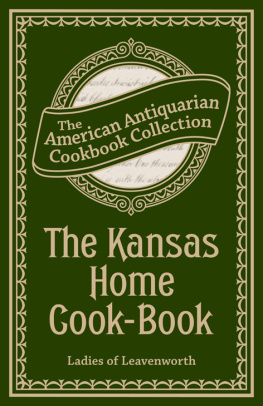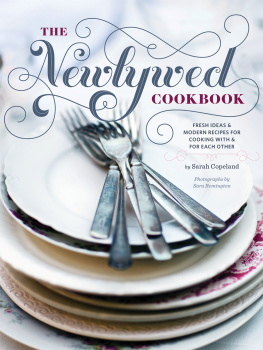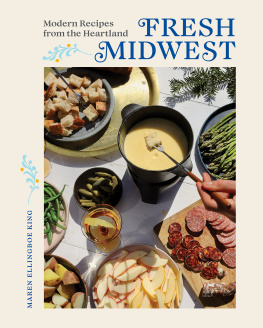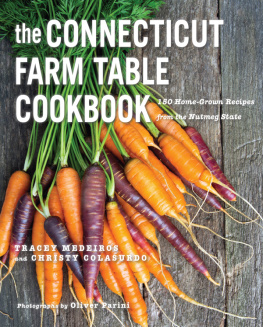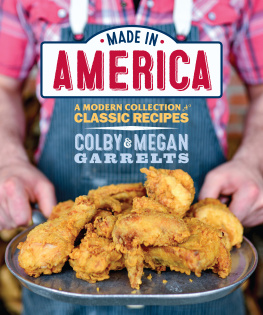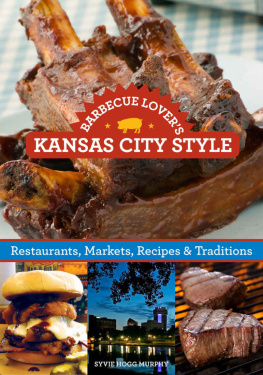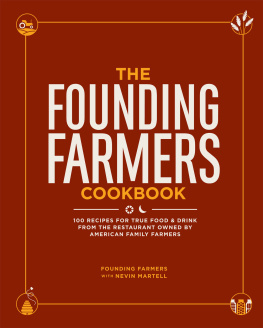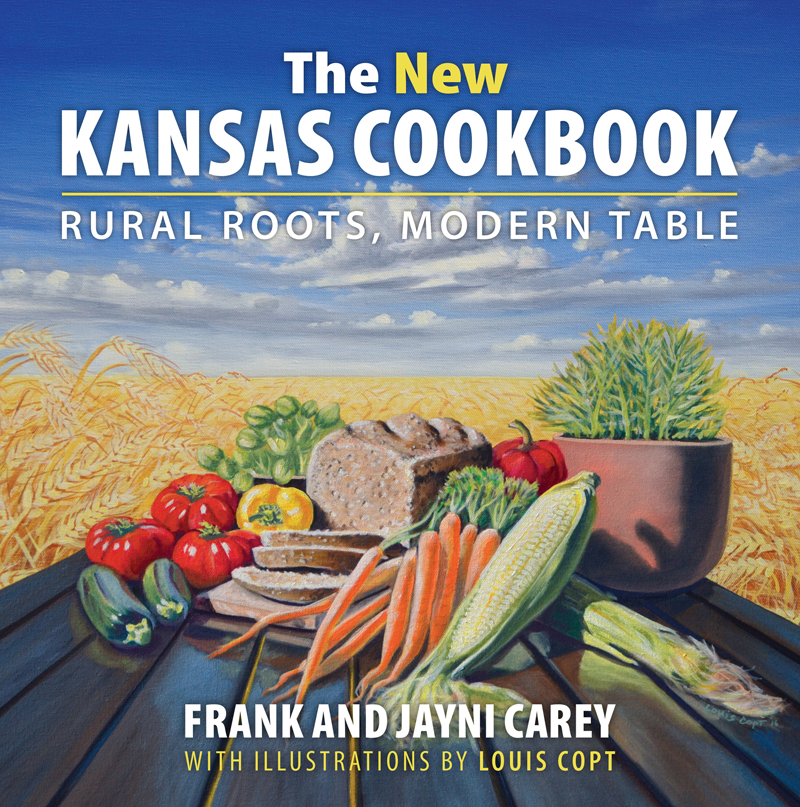The New
KANSAS COOKBOOK
RURAL ROOTS, MODERN TABLE

FRANK AND JAYNI CAREY
WITH ILLUSTRATIONS BY LOUIS COPT

2016 by Frank Carey and Jayni Carey
All rights reserved
Cover and interior illustrations 2016 by Louis Copt
Published by the University Press of Kansas (Lawrence, Kansas 66045), which was organized by the Kansas Board of Regents and is operated and funded by Emporia State University, Fort Hays State University, Kansas State University, Pittsburg State University, the University of Kansas, and Wichita State University
Library of Congress Cataloging-in-Publication Data
Names: Carey, Frank, 1949 author. | Carey, Jayni, author.
Title: The new Kansas cookbook : rural roots, modern table / Frank and Jayni Carey ; with illustrations by Louis Copt.
Description: Lawrence, Kansas : University Press of Kansas, [2016] | Includes index.
Identifiers: LCCN 2016023586 | ISBN 9780700623198 (cloth : alk. paper) | ISBN 9780700624553 (ebook)
Subjects: LCSH: Cooking, AmericanMidwestern style. | CookingKansas. | LCGFT: Cookbooks.
Classification: LCC TX715.2.M53 C366 2016 | DDC 641.59781dc23
LC record available at https://lccn.loc.gov/2016023586.
British Library Cataloguing-in-Publication Data is available.
Printed in the United States of America
10 9 8 7 6 5 4 3 2 1
The paper used in this publication is recycled and contains 30 percent postconsumer waste. It is acid free and meets the minimum requirements of the American National Standard for Permanence of Paper for Printed Library Materials Z39.48-1992.
Preface
So, whats cooking in Kansas?
In The Kansas Cookbook: Recipes from the Heartland, published in 1989, we looked back at the early foodways of Kansas. The book focused on recipes based on farm traditions, early settlers ethnic heritage, and favorite family recipes. Lets fast-forward twenty-seven years. Kansans continue to be proud of their rural roots but there is a new twist on the way we cook. The current trend is to eat fresh and local but it is no mere fad. Its a lifestylea lifestyle based on rural traditions with modern appeal.
The farm-to-table trend is growing in Kansas, as well as nationally, and there is no place where it is more evident than your local farmers market. Kansas is also a source for many of the wholesome foods that we need and desire. If Kansans cant grow it themselves, they want to purchase it locally, seasonally, and freshly harvested. In more populated areas, farmers markets have become colorful family events intertwined with the identity of the community. Its the place to be on Saturday morning. People are digging deeper to uncover more ways to purchase and share whole foods. Community Supported Agriculture (CSA) programs and you-pick farms offer opportunities to get fresh fruits and vegetables at their peak of ripeness. Some farms invite folks to visit and buy organic meats, eggs, cheeses, and other farm-made products right at their source. Some schools are growing their own produce to augment the school lunch program and even sell the surplus to the public. Parents want their kids to know where their food comes from so they are planting vegetable gardens, herb beds, salsa gardens, an asparagus patch, or just a couple of berry bushes in the backyard. The desire to drop seeds into the earth is fueled by the joy of watching the plants spring forth, as if completing the circle to eat what we have sown for ourselves.
When interviewing people around the state, we learned what Kansans cook with the abundance of fresh, seasonal, and local ingredients available to them. What could be more local to Kansas than a simple wheat berry pilaf with black walnuts and sunflower seeds? It reminds the contributor of the wheat crop and the walnut trees on the family farm. A deer hunter sends us her venison chili recipe and another cook, who loves growing strawberries, describes how to make her favorite pie.
To honor Kansans love of beef, we grilled steaks and concocted a sauce of mushrooms and locally made bourbon, pressure-cooked a brisket for sloppy joes, and embellished a salad of fresh and cooked vegetables with thin slices of steak. Chefs, some from small-town cafes and others from award-winning urban restaurants, generously offered their most popular recipes, never failing to mention their passion for sourcing foods from local purveyors or even their own gardens. One small-town establishment shares a zucchini and corn casserole and a perfected sweet cornbread recipe, while another eatery provides a deliciously inventive method for slow-roasting pork shoulder for its popular pork shoulder sandwich. And, for something with a little panache, several award-winning restaurants share recipes such as smoked duck empanadas, rainbow trout with a spicy crust, and roast pork tenderloin with Port wine and prunes. A farmer raising poultry tells how to make the best chicken and noodles and a rancher shares her recipe for ground grass-fed beef stuffed and baked in yellow squash. Thanks to the many options that keep cooks in seasonal produce, a bounty of recipes for vegetables such as stuffed acorn squash, Brussels sprouts roasted with bacon and apples, sweet corn with shallot and tarragon, and many recipes using fresh tomatoes found their way into the book. And after all, since Kansas is the Wheat State, family and consumer science educators share their expertise on making breads, rolls, and desserts.
Features are peppered throughout the book to showcase the people, places, and perhaps the future of our diverse agricultural state. We think that readers will be pleasantly surprised, as we were, to learn that chestnuts are grown in Kansas and that a nationally renowned poultry farmer is on a mission to save his heritage turkeys and chickens. For more than fifty years, a western Kansas town has been hosting a farm-to-table dinner for fifteen hundred diners with all the ingredients grown by local farmers and prepared by community volunteers. A six-generation wheat-farming family tells us how the modern wheat harvest has changed the traditional harvest meals, and two former Kansas governors share their enthusiasm for turkey hunting. To amuse us, a cheesemaker tells us why she prefers goats to cows, while a brewery, a winery, and a distillery all express their dedication and passion to their crafts.
The New Kansas Cookbook: Rural Roots, Modern Table is filled with 220 well-tested recipes from contributors, as well as ourselves, that reflect how Kansans cook today. Thirty-one features are inserted among the recipes to paint a backdrop of our states current foodways and its unique individuals. Though Kansas is a state that is large in area and diverse in character, we have discovered again that when it comes to sharing a meal, it still has a neighborly feel.
Acknowledgments
Writing The New Kansas Cookbook: Rural Roots, Modern Table has given us the opportunity to collaborate with many Kansans who shared their recipes, comments, and stories with us. We offer our heartfelt thanks to the Kansas cooks, chefs, farmers, ranchers, and family and consumer science educators who submitted recipes or allowed us to interview them for their unique stories. We wish to express our deep appreciation to Marci Penner, who was instrumental in helping us get the word out as we were searching for contributors, and a warm thank-you to our dear friends, Karen Waite, for assisting with recipe testing, and Susan Schott, Mike Briggs, and Ann Hagedorn, who gave us sage advice and encouragement while we were working on the book.


